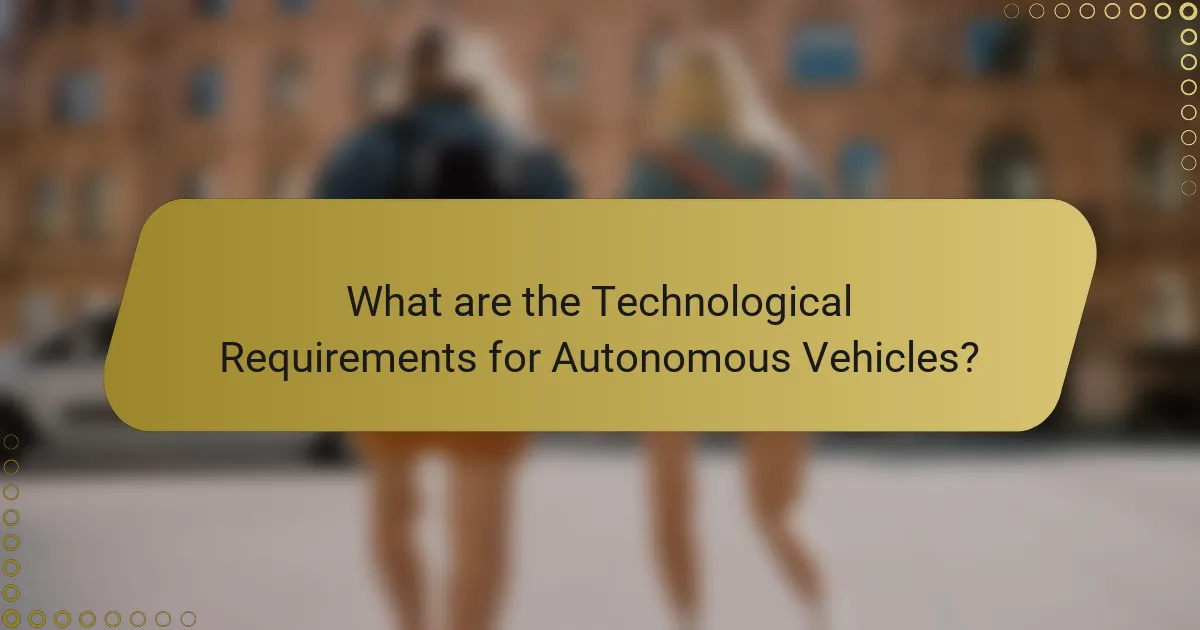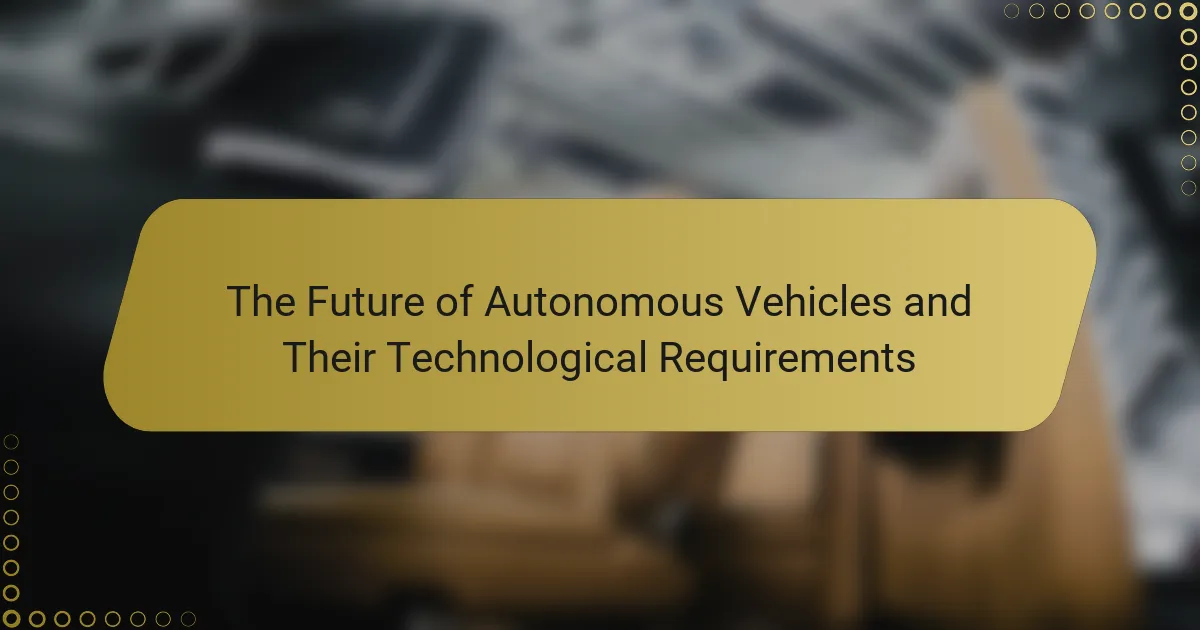Autonomous vehicles are self-driving cars that utilize a combination of sensors, cameras, and artificial intelligence to navigate and operate without human input. This article explores the technological requirements necessary for the safe and efficient deployment of these vehicles, including high-definition sensors, powerful computing systems, and robust software algorithms. It also highlights the potential impact of autonomous vehicles on urban mobility, emphasizing their ability to enhance traffic flow, reduce congestion, and improve safety by significantly decreasing traffic fatalities. Furthermore, the article discusses the broader implications for urban planning, infrastructure, and environmental sustainability as cities adapt to the increasing presence of autonomous vehicles.

What are Autonomous Vehicles and Their Role in the Future of Transportation?
Autonomous vehicles are self-driving cars that operate without human intervention. They use a combination of sensors, cameras, and artificial intelligence to navigate and make decisions. These vehicles are designed to enhance road safety by reducing human errors, which account for 94% of traffic accidents according to the National Highway Traffic Safety Administration. Additionally, autonomous vehicles can improve traffic flow and reduce congestion through optimized driving patterns. They also have the potential to provide mobility solutions for individuals unable to drive, such as the elderly and disabled. The future of transportation will likely see increased adoption of these vehicles, with projections estimating that by 2030, there could be over 33 million autonomous vehicles on the road globally. This shift could lead to significant changes in urban planning and infrastructure, as cities adapt to accommodate self-driving technology.
How do Autonomous Vehicles function?
Autonomous vehicles function through a combination of sensors, software, and artificial intelligence. They utilize cameras, radar, and lidar to perceive their environment. These sensors collect data about surroundings, including obstacles, lane markings, and traffic signals. The data is processed by onboard computers using complex algorithms. This processing enables the vehicle to make real-time driving decisions. Autonomous vehicles rely on machine learning to improve their performance over time. They also use pre-mapped routes and GPS for navigation. According to the National Highway Traffic Safety Administration, fully autonomous vehicles can potentially reduce traffic accidents significantly.
What technologies drive the functionality of Autonomous Vehicles?
Autonomous vehicles rely on several key technologies for their functionality. These include sensors, artificial intelligence, machine learning, and connectivity systems. Sensors, such as LiDAR, radar, and cameras, help vehicles perceive their surroundings. They provide real-time data about obstacles, road conditions, and traffic signals. Artificial intelligence processes this information to make driving decisions. Machine learning algorithms improve the vehicle’s performance over time by learning from data. Connectivity systems enable communication between vehicles and infrastructure. This exchange of information enhances safety and efficiency in navigation. Together, these technologies create a robust framework for autonomous driving.
How do sensors and cameras contribute to vehicle autonomy?
Sensors and cameras are essential for vehicle autonomy. They enable vehicles to perceive their environment accurately. Sensors detect objects, road conditions, and obstacles. Cameras provide visual data for recognizing traffic signs, lane markings, and pedestrians. Together, these technologies create a comprehensive understanding of surroundings. For instance, LIDAR sensors measure distances to objects with high precision. Cameras complement this by offering real-time visual context. Research shows that 90% of autonomous vehicle decisions rely on sensor data. This integration is crucial for safe navigation and decision-making in complex environments.
What are the key benefits of Autonomous Vehicles?
Autonomous vehicles offer several key benefits. They enhance road safety by reducing human error, which accounts for approximately 94% of traffic accidents. They improve traffic efficiency through optimized driving patterns, potentially reducing congestion by up to 30%. Autonomous vehicles can provide mobility for individuals unable to drive, such as the elderly and disabled. They also lower transportation costs by minimizing fuel consumption and maintenance needs. The technology behind these vehicles can lead to reduced emissions, contributing to environmental sustainability. Furthermore, they can facilitate better land use by decreasing the need for parking spaces. These benefits indicate a significant transformation in transportation systems.
How do Autonomous Vehicles improve road safety?
Autonomous vehicles improve road safety by reducing human error, which is a leading cause of accidents. These vehicles utilize advanced sensors and algorithms to detect obstacles and predict potential hazards. They operate with a higher level of precision than human drivers. Studies show that up to 94% of traffic accidents are due to human mistakes. Autonomous systems can react faster than humans in critical situations. For example, they can apply brakes or maneuver to avoid collisions in milliseconds. Furthermore, autonomous vehicles follow traffic laws consistently, reducing the risk of reckless driving. According to the National Highway Traffic Safety Administration, widespread adoption of autonomous vehicles could prevent millions of accidents annually.
What environmental impacts can Autonomous Vehicles have?
Autonomous vehicles can significantly reduce greenhouse gas emissions. They are designed to optimize driving patterns, which can lead to lower fuel consumption. A study by the International Council on Clean Transportation found that autonomous vehicles could reduce emissions by up to 60%. Additionally, these vehicles can promote the use of electric powertrains, further decreasing reliance on fossil fuels. They also have the potential to decrease traffic congestion. Reduced congestion can lead to fewer idling vehicles, which contributes to lower overall emissions. Furthermore, autonomous vehicles can facilitate car-sharing models. Car-sharing can reduce the number of vehicles on the road, leading to a smaller environmental footprint. Overall, the environmental impacts of autonomous vehicles are largely positive, particularly concerning emissions reduction and energy efficiency.

What are the Technological Requirements for Autonomous Vehicles?
Autonomous vehicles require advanced technologies to operate safely and efficiently. Key requirements include high-definition sensors such as Lidar, radar, and cameras. These sensors provide real-time data about the vehicle’s surroundings. Powerful computing systems process this data for decision-making. Robust software algorithms are essential for navigation and obstacle detection. Connectivity technologies like V2X (vehicle-to-everything) enhance communication with other vehicles and infrastructure. Machine learning models enable the vehicle to improve its performance over time. Safety protocols and redundancy systems ensure reliability and minimize failure risks. These technological elements are critical for the successful deployment of autonomous vehicles on public roads.
What types of technologies are essential for Autonomous Vehicles?
Essential technologies for Autonomous Vehicles include sensors, artificial intelligence, and connectivity systems. Sensors like LiDAR, cameras, and radar provide real-time data about the vehicle’s surroundings. Artificial intelligence processes this data to make driving decisions. Connectivity systems enable communication with other vehicles and infrastructure. These technologies work together to ensure safety and efficiency. According to the National Highway Traffic Safety Administration, these advancements are crucial for developing fully autonomous systems.
How do artificial intelligence and machine learning enhance vehicle performance?
Artificial intelligence and machine learning enhance vehicle performance by optimizing various operational aspects. They enable real-time data analysis from multiple sensors. This analysis improves decision-making for navigation and obstacle avoidance. Machine learning algorithms adapt to changing conditions, enhancing safety and efficiency. AI systems can predict vehicle maintenance needs, reducing downtime. They also enable better fuel efficiency through optimized driving patterns. According to a study by McKinsey & Company, AI can improve vehicle performance metrics by up to 30%. This demonstrates the significant impact of AI and machine learning on modern vehicles.
What role does connectivity play in the operation of Autonomous Vehicles?
Connectivity is essential for the operation of Autonomous Vehicles (AVs). It enables real-time communication between vehicles and external systems. This communication includes traffic management systems, other vehicles, and infrastructure. Such connectivity enhances situational awareness for AVs. It allows for data exchange on road conditions and obstacles. High-speed internet and low-latency connections are crucial for effective operation. According to a study by McKinsey, connected AVs could reduce traffic accidents by up to 90%. This statistic highlights the importance of connectivity in improving safety and efficiency in autonomous driving.
What are the challenges in developing Autonomous Vehicle technology?
Developing Autonomous Vehicle technology faces multiple challenges. Key issues include complex sensor integration, which is necessary for accurate environment perception. Vehicles must interpret data from cameras, LIDAR, and radar simultaneously. Another challenge is ensuring safety and reliability in varied driving conditions. Algorithms must handle unpredictable scenarios like pedestrians or sudden obstacles. Regulatory hurdles also impede progress, as laws vary by region and often lag behind technology. Additionally, public acceptance remains a concern, with many people hesitant to trust self-driving systems. Lastly, cybersecurity threats pose risks, as vehicles become more connected and reliant on software. These challenges require ongoing research and innovation to overcome.
How do regulatory hurdles affect the implementation of Autonomous Vehicles?
Regulatory hurdles significantly delay the implementation of Autonomous Vehicles (AVs). These hurdles include stringent safety standards, liability issues, and varying state regulations. Each state may have different rules regarding AV testing and operation. This inconsistency complicates the development process for manufacturers. Companies must navigate a complex legal landscape to ensure compliance. Moreover, regulatory bodies often require extensive data on vehicle performance and safety. This data collection can be time-consuming and costly. As a result, the pace of innovation in AV technology can be stifled. In summary, regulatory challenges create barriers that slow down the deployment of Autonomous Vehicles in the market.
What are the technological limitations currently faced by Autonomous Vehicles?
Autonomous vehicles currently face several technological limitations. One major limitation is sensor reliability in diverse weather conditions. For instance, heavy rain or fog can impair sensor performance, leading to reduced accuracy in navigation. Another limitation is the challenge of interpreting complex urban environments. Autonomous vehicles struggle with unpredictable human behaviors, such as jaywalking pedestrians or erratic cyclists. Additionally, the technology for real-time data processing is still evolving. Autonomous systems require extensive computational power to analyze the vast amounts of data collected from sensors. Furthermore, cybersecurity remains a significant concern. Autonomous vehicles are vulnerable to hacking, which can compromise safety and privacy. Lastly, regulatory and infrastructure challenges hinder widespread adoption. Many regions lack the necessary legal frameworks and smart infrastructure to support autonomous vehicle operations.

How will Autonomous Vehicles shape the future of urban mobility?
Autonomous vehicles will significantly transform urban mobility by enhancing efficiency and reducing congestion. They will optimize traffic flow through advanced algorithms and real-time data processing. This technology can lead to a decrease in travel times for commuters. According to the National Highway Traffic Safety Administration, autonomous vehicles could reduce traffic fatalities by up to 94%. Furthermore, these vehicles can facilitate shared mobility services, decreasing the number of individual car ownerships. This shift can lead to lower emissions and improved air quality in urban areas. Research by McKinsey & Company indicates that autonomous vehicle adoption could save cities billions in infrastructure costs. Overall, autonomous vehicles will create a more sustainable and efficient urban transportation landscape.
What urban infrastructure changes are needed for Autonomous Vehicles?
Urban infrastructure changes needed for Autonomous Vehicles include dedicated lanes, improved traffic signals, and enhanced signage. Dedicated lanes allow for safer and more efficient travel for autonomous vehicles. Improved traffic signals can communicate with vehicles, optimizing traffic flow. Enhanced signage ensures that autonomous systems can accurately interpret road conditions. Additionally, smart city technologies can support data sharing between vehicles and infrastructure. These changes are essential for integrating autonomous vehicles into existing urban environments. Studies indicate that cities adopting these changes will see significant improvements in traffic safety and efficiency.
How can cities adapt to accommodate the rise of Autonomous Vehicles?
Cities can adapt to accommodate the rise of Autonomous Vehicles (AVs) by redesigning infrastructure. This includes creating dedicated lanes for AVs to enhance safety and efficiency. Traffic signals and signage must be updated to communicate effectively with AVs. Parking facilities should be reimagined to support automated drop-off and pick-up zones. Urban planning must incorporate smart technology for real-time data sharing. Additionally, public transportation systems can integrate AVs to improve connectivity. Studies show that cities implementing these changes can enhance mobility and reduce congestion. For instance, a report by the Institute of Transportation Engineers highlights the potential for AVs to decrease traffic fatalities by 90%.
What impact will Autonomous Vehicles have on public transport systems?
Autonomous vehicles will significantly transform public transport systems. They can enhance efficiency by optimizing routes and reducing wait times. Studies indicate that autonomous shuttles can increase ridership by providing on-demand services. This technology may lower operational costs due to reduced need for human drivers. Additionally, autonomous vehicles can improve accessibility for individuals with disabilities. Research shows that integrating these vehicles can lead to decreased traffic congestion. A study by the International Transport Forum highlighted potential reductions in public transport operational expenses. Overall, autonomous vehicles are poised to reshape public transport dynamics positively.
What are the best practices for integrating Autonomous Vehicles into existing transportation systems?
The best practices for integrating Autonomous Vehicles (AVs) into existing transportation systems include establishing clear regulatory frameworks, enhancing infrastructure, and promoting public acceptance. Regulatory frameworks must define safety standards, operational guidelines, and liability issues for AVs. Infrastructure improvements are necessary to support AV technology, including dedicated lanes and smart traffic signals. Public acceptance can be fostered through education and outreach programs that inform communities about the benefits of AVs. Collaborating with stakeholders, including local governments and technology developers, ensures a holistic approach. Pilot programs can help test AV integration in real-world scenarios, providing data for future improvements. Continuous monitoring and data analysis will refine AV operations and enhance safety. These practices are essential for a smooth transition to a future with autonomous vehicles.
How can stakeholders collaborate to ensure successful integration?
Stakeholders can collaborate to ensure successful integration by establishing clear communication channels. Regular meetings can facilitate the sharing of insights and progress updates. Jointly developing standards and protocols is essential for interoperability. Stakeholders should engage in collaborative research and development initiatives. They can also share resources and expertise to accelerate innovation. Implementing pilot programs can provide real-world testing and feedback. Additionally, stakeholders must address regulatory and safety concerns collectively. This collaborative approach fosters trust and aligns objectives across all parties involved.
What lessons can be learned from early Autonomous Vehicle implementations?
Early Autonomous Vehicle implementations provide critical insights into safety, technology integration, and user acceptance. Safety issues emerged frequently, highlighting the need for robust testing protocols. For example, incidents involving Tesla’s Autopilot raised concerns about reliance on automation. Technology integration revealed challenges in sensor fusion and data processing capabilities. Early systems struggled with diverse driving environments, emphasizing the importance of adaptable algorithms. User acceptance studies showed mixed reactions, indicating a need for better public education on autonomous technology. These lessons underscore the importance of continuous improvement in safety measures and technology development for future implementations.
The primary entity of this article is Autonomous Vehicles, which are self-driving cars that utilize advanced technologies to navigate without human intervention. The article provides a comprehensive overview of the role of autonomous vehicles in future transportation, including their functioning, key technologies, benefits for road safety and the environment, and the necessary infrastructure changes. It also addresses the challenges faced in their development, such as regulatory hurdles and technological limitations, and explores how these vehicles will shape urban mobility and public transport systems. Additionally, best practices for integrating autonomous vehicles into existing transportation frameworks and lessons learned from early implementations are discussed.
